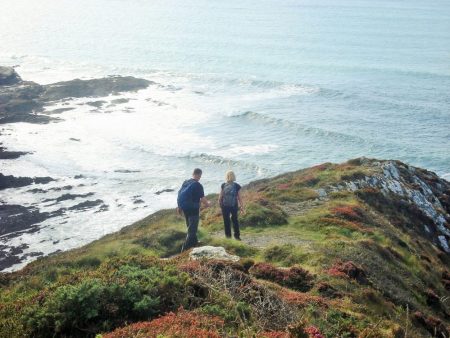The last stretch.
An interesting breakfast conversation with two Finnish ladies, mother and daughter, walking part of the SWCP, their English was of course perfect. There had been rain in the night but by the time I left there was no need for waterproofs, that’s 8 dry days in a row, and very soon the sky brightened. The headlands seemed busy this morning with people walking short stretches and using the connecting bus services. Between Porthcothan and Treyarnon the coast is deeply indented which meant lots of ups and downs but ever-changing scenery. The tide was high and in the wind there was quite a swell so all the little sea stacks were taking a bashing. In one narrow inlet the sea was being whipped up into a foam that was blowing up onto the tops just like snow.



Up here there were some good examples of ‘Cornish hedges’ which are really stone walls with plants growing in them. An ancient and lasting field boundary.



I was able to walk the long stretch of Constantine Beach on the sands. At the strangely named Booby Bay groups of bird watchers were focusing their attention on the rocks – all I could see were oyster catchers and gulls, not a Booby in sight.


I made the full traverse of Trevose Head passing a very large blow hole where you could just make out the sea below without risking your life. Dinas Head seemed to stick right out into the Atlantic with some impressive sea stacks The Quies a mile out and another The Bull closer at hand.



The way continued past the automatic lighthouse and in the next bay Padstow lifeboat station relocated here as the Camel Estuary silted up. You can see from the photos how rugged and dangerous this coast is and the need for the light and lifeboat. In the past many vessels came to grief on this stretch. 
I passed some drab looking holiday chalet sites which are probably deserted now, most people I met had rented cottages. After another headland Harlyn Bay was approached, rather than walk on the beach I headed inland to visit the pub for a coffee. Not the friendliest of hostelries I moved on quickly rather depressed by the area and the mist that had descended. 
 I think I’d had enough so consulting my ‘map’ I could see lanes cutting across to Padstow and made the decision to head direct and celebrate with fish and chips in Rick Stein’s cafe on the harbour. I arrived there only to find they had just closed at 3pm. A bus trip to Bodmin for the night and I was able to sample the same fare in Bell Lane probably at half the price.
I think I’d had enough so consulting my ‘map’ I could see lanes cutting across to Padstow and made the decision to head direct and celebrate with fish and chips in Rick Stein’s cafe on the harbour. I arrived there only to find they had just closed at 3pm. A bus trip to Bodmin for the night and I was able to sample the same fare in Bell Lane probably at half the price.
I was last in Padstow in October 2017 so I have now completed most of my LEJOG walk [over the period of 50 years] I have only a few more days walking up to John O’Groats itself, watch this space.














































































































































































































































































